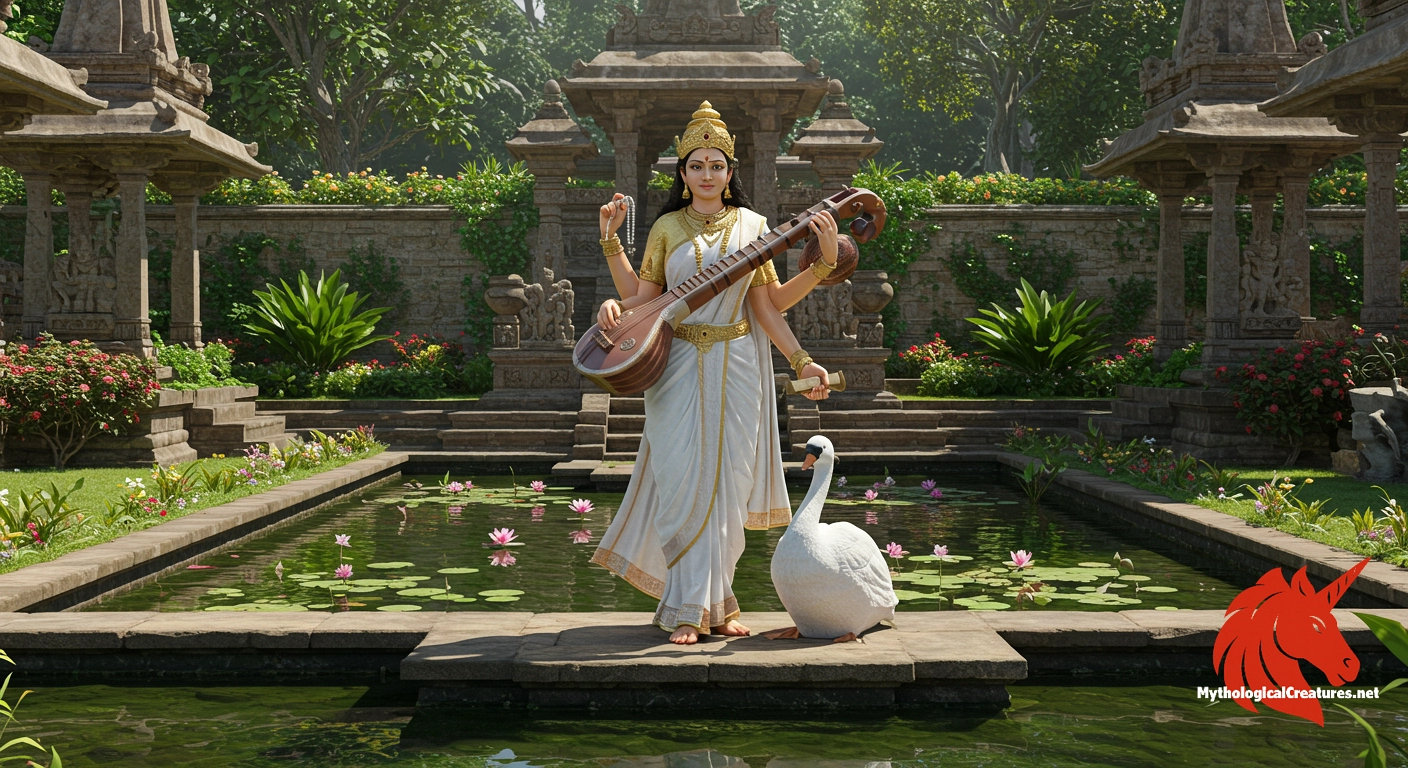Saraswati: Saraswati is the Hindu goddess of knowledge, arts, and wisdom, celebrated for her serene beauty and divine creative inspiration.

Saraswati
Saraswati - Represents the creative power (Shakti) behind the ordering of reality, inspiring learning and art across cultures
Origins & First Encounters
Saraswati embodies the refined and eternal principles of wisdom and knowledge, emerging from the ancient Vedic period as both a nurturing river deity and the patron of art and learning. Her early manifestations in sacred texts portray her as a force of nature, whose flowing qualities symbolised life, purity, and intellectual clarity. Over time, she evolved from a personification of riverine fertility into a divine muse of speech, poetry, and the creative arts. This transformation reflects the dynamic interplay between nature and intellect in early Indian thought. Her enduring significance is evident in her association with both the fluidity of water and the rigidity of scholarly pursuit, merging the physical with the metaphysical. As a pivotal figure in multiple religious traditions, she bridges the realms of Hinduism, Buddhism, and Jainism, underscoring her broad cultural impact. Her depiction as a goddess in serene white reinforces her symbolic connection with purity and the vibrancy of knowledge. The interweaving of her myth with the practices of learning and ritual celebration has cemented her status as an icon of intellectual inspiration. Throughout her storied history, Saraswati has come to represent the transformative power of education and the arts. In modern times, she continues to inspire countless devotees and scholars, serving as a beacon of clarity, creativity, and spiritual depth.
Source Texts & Tale Variants
Ancient literary traditions immortalise Saraswati through a rich array of texts and oral narratives that underscore her multifaceted character. Vedic hymns, particularly those found in the Rigveda, first introduced her as a vital, life-giving river, laying the groundwork for her later associations with learning and culture. Subsequent scriptures, including the Brahmanas and Upanishads, expanded her identity by intertwining her with the goddess of speech and artistic expression. In some narratives, her persona gracefully merges with Vac, thereby symbolising the seamless union of nature and verbal creativity. Diverse local folklore further colours her story, offering alternate interpretations that emphasise her role in nurturing both intellectual pursuits and natural abundance. Inscriptions on ancient temple walls and manuscripts have also preserved varying accounts of her divine essence, further attest to her wide appeal. Indian classical literature often depicts her as the creative impulse behind the Sanskrit language, elevating her status to that of a cosmic muse. Yet another tradition venerates Saraswati as the consort or emanation of Brahma, underscoring her role as an agent of universal creation. These multiple layers of textual evidence illustrate the dynamic interplay of ideas that have shaped her legacy over millennia. Such variant narratives not only enrich the tapestry of her myth but also invite ongoing reinterpretations in each subsequent era.
Form & Powers
Saraswati is typically portrayed as an ethereal figure radiating calm and intellectual grace, with her appearance designed to evoke a sense of serene purity. Her immaculate white attire symbolises not only spiritual cleanliness but also the clarity of mind associated with scholarly pursuits. She is universally depicted with four arms, each gracefully holding an object that encapsulates different aspects of knowledge—the sacred book as a repository of wisdom, the rosary representing meditative continuity, the water pot for purification, and the veena as a tribute to the musical arts. Her delicate features convey both compassion and an unwavering focus, inviting devotees into a state of reflective tranquillity. The intricate details of her jewellery and the subtle curvature of her form further highlight her divine elegance. Classical depictions often show her seated in a contemplative posture, underlining an inner calm that suggests an unfathomable depth of learning. Artistic renditions may vary, with regional influences imbuing her with local nuances in attire and ornamentation. The attendant mount, usually a hamsa or a swan, complements her poise by symbolising graceful intellect and purity of spirit. Each component of her image is steeped in symbolism, crafted to inspire a sense of wonder and reverence among those who encounter it. The visual narrative of Saraswati continues to evolve, yet her timeless iconography remains a definitive emblem of beauty and erudition.
Regional Faces
The depiction of Saraswati adapts gracefully to the regional and cultural subtleties across the Indian subcontinent and beyond. In northern India, traditional iconography strongly emphasises her role as the patron of learning and eloquence, often linked with time-honoured academic practices. Southern traditions, meanwhile, may incorporate indigenous artistic motifs and locally revered textiles into her portrayal, providing a unique flavour to her divine image. In Kashmir, the ancient Sharada Peeth temple stands as a testament to a local resurgence of her mystical attributes, interlacing cosmic symbolism with regional artistic styles. Rural communities sometimes accentuate her origin as a river goddess, celebrating her as a source of both agricultural fertility and intellectual rejuvenation. The annual celebration of Vasant Panchami across various regions further illustrates these local adaptations, where diverse rituals and traditions pay homage to her blessings. In East Asia, particularly in Japan, her transfiguration into Benzaiten reveals a structured fusion of her inherent qualities with local spiritual understandings. These cultural reinterpretations allow her to remain relevant and resonate with diverse audiences while preserving core elements of her identity. Whether invoked as the divine muse in elaborate temple rituals or revered in intimate, home-based ceremonies, Saraswati’s image continuously adapts to embrace both universal spiritual truths and local cultural expressions. Her versatile representation across regions is a vibrant reflection of the dynamic interplay between global religious ideas and regional traditions.
Cultural Parallels
Saraswati’s attributes find harmonious echoes in various mythological traditions around the world, where the celebration of knowledge and artistic brilliance is a universal theme. Comparable figures such as the Greek goddess Athena and the Roman Minerva similarly symbolise wisdom, creativity, and the martial aspects of intellect, albeit with distinct cultural inflections. While Athena is revered as a protector of cities and ingenuity in craft, Saraswati’s focus is more closely aligned with the literary and musical realms, reflecting the unique value placed on education in her cultural context. In East Asia, the evolution of Benzaiten from Saraswati further exemplifies how her foundational qualities have been woven into a uniquely local tapestry of religious practice. These cross-cultural comparisons highlight a shared human esteem for the transformative power of the mind and the arts. Although the specific iconography and associated narratives vary, the core virtues of enlightenment, creative passion, and scholarly endeavour remain consistent. Such comparative analysis suggests that the veneration of a divine muse is a recurring motif in global mythology, underlying a collective respect for intellectual progress. Regional adaptations underscore the flexible nature of divine symbolism, allowing each culture to imbue its own identity into the archetype of wisdom. The convergence of these mythological figures underlines the cultural significance accorded to learning and creativity. Through this lens, Saraswati not only stands as an Indian deity but also as part of a broader, inter-cultural reverence for the pursuit of knowledge across civilizations.
Legacy & Modern Evolution
The evolution of Saraswati’s persona over millennia reflects a deep and enduring transformation from her Vedic roots to a modern symbol of intellectual and artistic brilliance. Initially celebrated as a life-giving river goddess, her early legacy laid the foundations for a broader interpretation centred on the virtues of speech and learning. As centuries passed, her role shifted to embody the creative spirit behind literature, music, and the arts, resonating with the aspirations of both royal patrons and common scholars. Classical depictions gradually distilled her image into one of serene purity, with her immaculate white attire and four symbolic arms coming to represent the multifaceted nature of knowledge. In modern times, her influence is manifest during cultural celebrations such as Vasant Panchami, when students and educators alike invoke her blessings in the pursuit of learning. Contemporary representations of Saraswati extend beyond traditional art, appearing in modern media, academic logos, and public festivals that celebrate intellectual endeavour. Her timeless image continues to inspire new artistic expressions, bridging the divide between ancient ritual and modern innovation. The shifting portrayals of her character reveal a dialogue between enduring traditions and evolving societal values. As a symbol of both creative inspiration and educational empowerment, Saraswati’s legacy is a living tradition that adapts to the needs of successive generations. Today, she remains a universally revered emblem of enlightenment whose historical journey mirrors the evolution of human thought and cultural expression.
Interesting Fact
A fascinating aspect of Saraswati is her evolution from a river goddess in the Vedic era to a multifaceted deity celebrated for fostering both artistic creativity and intellectual rigor across diverse cultures.
Quick Creature Info
Associations:
Our Mythic Legendary Rating:

Also Sometimes Known As:
Habitat:
Supernatural Powers:
Physical Attributes:
Abilities:
Behavior:
Lore:
Related Creatures, Tales or Lore
- BBenzaiten
- AAthena
- SSeshat
References
Discover Another Mythical Legend You May Not Have Heard Of?
Uncover the mysteries of ancient folklore and expand your knowledge of legendary beings from cultures around the world.
Dare to Meet the Luduan....
Mythical Disclaimer: The images and data on this site are derived from various historical and literary sources, but we have found that many myths often have multiple versions and interpretations across references, sometimes contradictory. As a result, these creature depictions are artistic interpretations—imaginative blends of folklore, legend, and a dash of AI guesswork. Because creature descriptions vary widely, our illustrations and accompanying information represent our best effort to honor mythology while bridging creative gaps. Enjoy these interpretations—just remember, we've done our best to respect the stories and validate available data, but in the realm of mythology, details often shift, imagination leads the way, and nothing is ever set in stone!
Curated by the Mythological Creatures Team (rev. May 2025)
